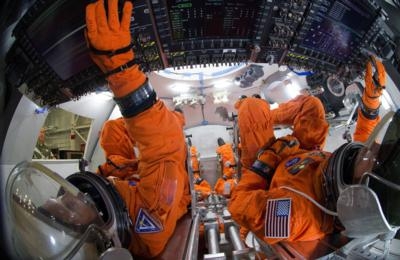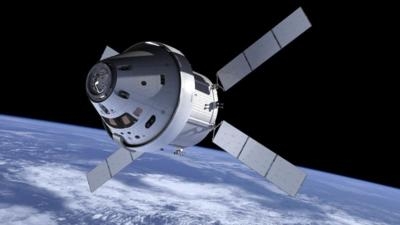But First Manned Flight Has Been Delayed By Two Years
NASA’s mission to send astronauts to deep space destinations where no other human has traveled has taken another important step forward with the completion of a critical milestone for the Orion spacecraft currently in production. However, the agency says that due to budget constraints, the first manned mission will not take place until April 2023, at the latest.

Agency officials have completed a rigorous technical and programmatic review, confirming continued support of the program and establishing NASA’s commitment to the program’s technical, cost, and schedule baseline. This is the first time NASA has reached this level of progress for a spacecraft designed to take humans into deep space beyond the moon, including to an asteroid placed in lunar orbit and on the journey to Mars.
“Our work to send humans out into the solar system is progressing,” said NASA Administrator Charles Bolden. “Orion is a key piece of the flexible architecture that will enable humanity to set foot on the Red Planet, and we are committed to building the spacecraft and other elements necessary to make this a reality.”
A successful test of an uncrewed Orion capsule, Exploration Flight Test-1 (EFT-1), flew in December 2014, providing important data that allowed engineers to identify risks associated with deep space flight and re-entry and use that knowledge to improve the design of Orion for its next test flights, Exploration Missions 1 and 2 (EM-1 and EM-2).
Performance data has helped to improve manufacturing processes, as well. Engineers have already incorporated many of these improvements into elements of the EM-1 design, including the crew compartment or pressure vessel, which now is in fabrication and assembly at companies across the country. The vessel is comprised of seven panels or sections, and the first two of these were welded together last week. When complete, this capsule will launch on NASA’s Space Launch System (SLS) rocket on the first fully integrated flight test, EM-1.
Astronauts will fly on Orion for the first time on EM-2. That mission will build on the results of the EM-1 flight with additional requirements that the Orion capsule includes fully integrated environmental control and life support systems; controls; and communications designed specifically for the human operation; and advanced launch and re-entry spacesuits for the crew. The recent review, culminating in what is known within NASA as Key Decision Point C (KDP-C), includes all of these technological advancements, and approval represents agency support for this work and the Orion program plan.

The decision commits NASA to a development cost baseline of $6.77 billion from October 2015 through the first crewed mission (EM-2) and a commitment to be ready for a launch with astronauts no later than April 2023. The agency had planned to fly that mission in 2021. The commitment is consistent with funding levels in the president’s budget request. Conservative cost and schedule commitments outlined in the KDP-C align the Orion Program with program management best practices that account for potential technical risks and budgetary uncertainty beyond the program's control.
“As we take these steps to develop the capabilities we need to send astronauts deep into space, we’re also aligning how we manage our human exploration systems development programs to ensure we are prepared for unforeseen future hurdles,” said Robert Lightfoot, NASA associate administrator. “We’re committing to this funding and readiness level to stay on the journey we’ve outlined to get to Mars.”
Orion engineers now are executing a rigorous review of the spacecraft’s engineering design and technical progress of the vehicle systems and subsystems. This critical design review (CDR) will demonstrate Orion is ready to proceed to full-scale fabrication, assembly, integration and testing. NASA’s SLS Program recently completed this milestone, and its Ground Systems Development and Operations (GSDO) Program will begin its review this fall.
“The Orion Program has done incredible work, progressing every day and meeting milestones to prepare for our next missions,” said William Gerstenmaier, the agency’s associate administrator for Human Exploration and Operations at NASA Headquarters. “The team will keep working toward an earlier readiness date for a first crewed flight, but will be ready no later than April 2023, and we will keep the spacecraft, rocket and ground systems moving at their own best possible paces.”
In the coming months, Orion will complete its CDR; see the arrival of a test version for the European Space Agency-provided service module at NASA’s Plum Brook Station near Sandusky, Ohio; perform a series of parachute tests; and complete the welding of the crew pressure vessel. Although Orion’s readiness date for EM-1 was not formally part of the KDP-C milestone commitment, engineers continue to work toward a commitment for SLS and GSDO to be ready for the uncrewed mission in fall 2018, and NASA will set an integrated launch date after GSDO’s critical design review is completed.
(Images provided by NASA)
 Airborne-Flight Training 05.09.24: ERAU at AIAA, LIFT Diamond Buy, Epic A&P
Airborne-Flight Training 05.09.24: ERAU at AIAA, LIFT Diamond Buy, Epic A&P ANN's Daily Aero-Term (05.07.24): Hazardous Weather Information
ANN's Daily Aero-Term (05.07.24): Hazardous Weather Information Aero-News: Quote of the Day (05.07.24)
Aero-News: Quote of the Day (05.07.24) NTSB Final Report: Cessna 150
NTSB Final Report: Cessna 150 Aero-News: Quote of the Day (05.08.24)
Aero-News: Quote of the Day (05.08.24)




